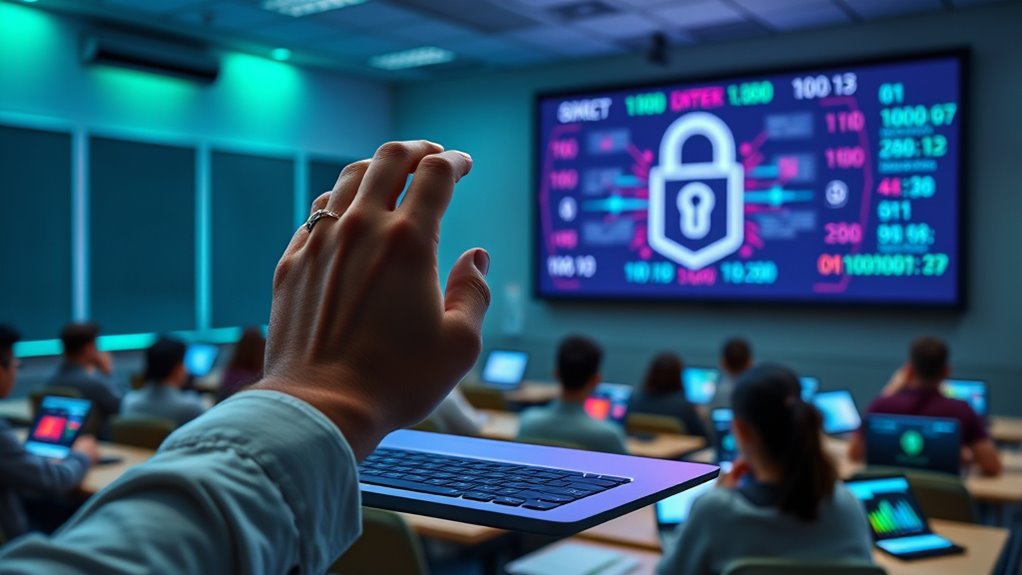Protecting student data in education requires your active effort to understand common cyber threats like phishing and weak passwords. Implement strong password policies, encourage multi-factor authentication, and stay vigilant for suspicious emails or links. Regular cybersecurity training for staff and students helps build a culture of awareness. Remember, cybersecurity isn’t a one-time effort; ongoing vigilance keeps sensitive information safe. Keep going to discover more strategies that can strengthen your school’s defenses.
Key Takeaways
- Implement strong password policies and encourage use of password managers to prevent unauthorized access.
- Conduct regular cybersecurity training to raise awareness about phishing scams and safe online practices.
- Use multi-factor authentication to add extra security layers for accessing sensitive student data.
- Monitor networks continuously for suspicious activity and ensure up-to-date security software is in place.
- Foster a security-conscious culture among staff and students to reduce vulnerabilities and promote proactive defenses.

Have you ever considered how vulnerable educational institutions are to cyber threats? Schools and universities hold a treasure trove of sensitive data, from student records to financial information, making them prime targets for cybercriminals. The good news is that many attacks can be thwarted with basic yet effective cybersecurity practices. One critical aspect is fostering Phishing Awareness among staff and students. Phishing scams are increasingly sophisticated, often appearing as legitimate emails or messages that trick recipients into revealing login details or clicking malicious links. By educating everyone in your institution about how to recognize these deceptive tactics, you considerably reduce the chances of falling victim. Encourage skepticism—always verify the sender’s email address, avoid clicking on suspicious links, and be cautious when asked to provide personal or login information. Creating a culture of vigilance around phishing can save your institution from potential data breaches and the costly fallout that follows.
Alongside phishing awareness, robust Password Management forms a cornerstone of cybersecurity. Weak or reused passwords are a common vulnerability exploited by hackers. Teaching staff and students to create strong, unique passwords for each account is essential. Consider implementing password policies that require a mix of uppercase and lowercase letters, numbers, and special characters. Using password managers can simplify the process, allowing users to generate and store complex passwords securely without the need to remember each one. Regularly updating passwords and avoiding sharing login credentials further enhances security. It’s also crucial to educate users about the dangers of writing passwords down or storing them insecurely. When everyone adopts good password management habits, it becomes much harder for cybercriminals to access confidential data. Additionally, promoting cybersecurity awareness can help build a resilient environment where everyone understands their role in defending digital assets.
In addition to these practices, institutions should implement multi-factor authentication whenever possible. This adds an extra security layer, making it more difficult for hackers to compromise accounts even if login details are stolen. Regular cybersecurity training sessions can reinforce these habits, ensuring that staff and students stay alert and prepared. Remember, cybersecurity isn’t a one-time effort; it’s an ongoing process of awareness, education, and proactive measures. By emphasizing phishing awareness and proper password management, you’re empowering your institution to defend against cyber threats more effectively. Protecting student data is not just about installing firewalls or antivirus software; it’s about cultivating a security-minded environment where everyone plays a role in safeguarding sensitive information. The more vigilant and educated your community is, the less likely cybercriminals will succeed in exploiting vulnerabilities. Ultimately, a strong security culture starts with informed individuals making smart choices every day.
Frequently Asked Questions
How Often Should Schools Update Their Cybersecurity Protocols?
You should update your school’s cybersecurity protocols at least annually to stay ahead of emerging threats. Regular cybersecurity training for staff and students reinforces best practices, while consistent policy reviews ensure your defenses adapt to new challenges. By making these updates a routine part of your cybersecurity strategy, you mitigate vulnerabilities, protect student data, and maintain a secure learning environment. Staying proactive is key to effective cybersecurity in education.
What Are the Best Tools for Protecting Student Information?
Think of your school’s data as a treasure chest. To safeguard it, you need strong encryption methods that lock sensitive information tightly and access controls that restrict entry to authorized personnel. These tools act like a secure lock and key system, preventing unauthorized access. By combining encryption with strict access controls, you ensure student data stays safe, just like a treasure protected from thieves.
How Can Parents Help Ensure Data Privacy?
You can help guarantee data privacy by staying actively involved in your child’s digital life. Foster parental involvement by discussing online safety regularly and setting clear boundaries. Boost data privacy awareness by teaching your kid to use strong, unique passwords and recognize suspicious activity. Encourage them to ask questions about their data and privacy rights. Your proactive approach helps protect their information and promotes responsible digital habits.
What Are Common Cybersecurity Threats in Education?
Oh, the joys of modern education—where phishing scams and malware attacks lurk behind every click. You’re often targeted by cunning scammers pretending to be trusted sources, trying to steal sensitive student data. Malware can sneak in through infected links or downloads, wreaking havoc on school networks. Staying vigilant, using strong passwords, and keeping systems updated help defend against these common threats. Don’t let cyber villains spoil your learning experience!
How Do Schools Recover From Data Breaches?
When a data breach occurs, you should activate your incident response plan immediately, isolating affected systems to prevent further damage. Work with IT specialists to conduct a thorough investigation, identify the breach source, and assess data loss. Then, focus on data recovery by restoring backups and strengthening security measures. Communicate transparently with stakeholders, ensuring ongoing vigilance to prevent future incidents and maintain trust.
Conclusion
Remember, an ounce of prevention is worth a pound of cure. By staying vigilant and implementing strong cybersecurity measures, you protect your students’ data and guarantee a safe learning environment. Don’t wait for a breach to realize its impact—be proactive today. Educators and administrators, your efforts make all the difference in safeguarding sensitive information. Keep security at the forefront, and you’ll build trust and resilience in your educational community. Stay vigilant, stay secure.









